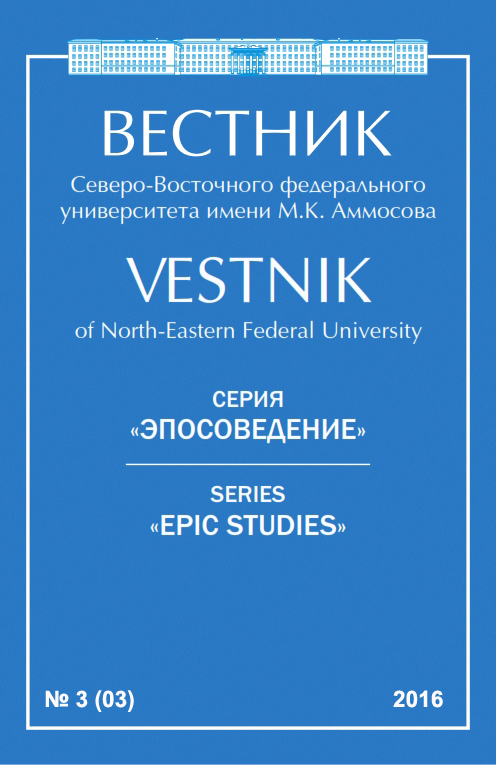EMOTIONALLY COLORED WORDS IN THE OLONKHO “NURGUN BOTUR, THE SWIFT” BY K. G. OROSIN
DOI:
https://doi.org/10.25587/SVFU.2016.3.10869Keywords:
emotion, emotionality, emotionally colored words, evaluation, intensity, imagery, comparative analysis, translation techniques, replacement, generalization.Abstract
The topic of discussion in this article is of a great significance because it gives a detailed insight into the transfer of specific national and cultural features of fiction. It is very difficult task for a translator to achieve. Olonkho is considered to be a masterpiece of Yakut folklore and a synthesis of many arts because of its unique style and a great number of emotionally colored words used frequently throughout the text this makes it one of the most difficult epics for translation. Difficulties in translating an Olonkho may also occur due to the fact that the texts of source language and target language reflect different cultures. The aim of the article is to analyze emotionally colored words in the Olonkho “Nurgun Botur, the Swift” by K. G. Orosin and also to investigate means of its translations from Russian into French.
The research had revealed the following: emotionally colored words are mostly commonly represented by: nouns (46%), adjectives (39%) and verbs (15%). The following lexical transformations were used in the process of translating from Yakut into Russian and English: generalization, descriptive translation, lexical replacement, omission and addition. We identified that translated text from Yakut into Russian have only 20% nouns, 26% verbs and of 29% adjectives that are of absolute conformity with the original language. Nearly 50% of emotionally colored words are marked by partial equivalence and nearly 30% of the words have no direct equivalents. In the Yakut-French translation, full equivalence occurs in nouns (16%), adjectives (13%) and verbs (13%). Partial equivalence was indicated in nouns (30%) and 50% of the words have no direct equivalence. Partial semantic losses are inevitable on the connotative level in the process of translating the emotionally colored words. Translators have to solve such difficult tasks in order to avoid semantic and imagery losses. The translation analysis revealed that it is necessary to investigate the problem of connotation in epic literature more deeply.
References
- Brandes M. P. Pozicija pisatelja i stil’ literaturnogo proizvedenija. – M.: Vyssh. shk., 2002. – 148 s.
- Vol’f E. M. Funkcional’naja semantika ocenki. – M.: Vyssh. shk., 1985. – 254 s.
- Galkina-Fedoruk E. M. Ob jekspressivnosti i jemocional’nosti v jazyke // Sbornik statej po jazykoznaniju. – M.: Izd-vo MGU, 1958. – S. 103-105.
- Dolinin K. A. Stilistika francuzskogo jazyka. – L.: Prosveshhenie, 1978. – 344 s.
- Leont’ev A. N. Psihologija obshhenija. – L.: Prosveshhenie, 1954. – 208 s.
- Nemov R. S. Obshhaja psihologija. – SPb.: Piter, 2006. – 304 s.
- Harchenko V. K. Razgranichenie ocenochnosti, obraznosti, jekspressii i jemocional’nosti // Russkij jazyk v shkole. – M.: Prosveshhenie, 1976. – № 3. – S. 66-71.
- Luk’janova N. A. Jekspressivnaja leksika razgovornogo upotreblenija. – Novosibirsk: Nauka, 1986. – 160 s.
- Shmelev D. N. Sovremennyj russkij jazyk: leksika. – M.: Uchpedgiz, 1977. – 335 s.
- Lihanov V. I. Jemocional’no-ocenochnye i jekspressivnye slova v jakutskom jazyke. – Novosibirsk: Nauka, 1994. – 144 s.
- Orosin K. G., Jergis G. U. Njurgun Bootur Stremitel’nyj. – Jakutsk: Gos. izdat. SSSR, 1947. – 358 s.
- Tolkovyj slovar’ jakutskogo jazyka / Pod red. A. Slepcova. – T. I-III. – Novosibirsk: Nauka, 2004.
- Pekarskij Je. K. Slovar’ jakutskogo jazyka. – SPb.: Nauka, 2008. – T. I-III.
- Karro Y. Niourgoun le Yakoute, guerrier célèste. Les guerriers célèstes du pays Yakoute – Saxa. Paris: Gallimard, 1994. – 54 p. (na franc. jaz.)
- Ozhegov S. I. Slovar’ russkogo jazyka / Pod obshh. red. prof. L. I. Skvorcova. – M.: Mir i obrazovanie, 2004. – 1200 s.
- Dal’ V. I. Tolkovyj slovar’ russkogo jazyka. Sovremennaja versija. – M.: ZAO JeKSMO-PRESS, 2002. – 736 s.
- Petit Robert. Dictionnaire de la langue française. – Paris, 2004. (na franc. jaz.)
- Kratkij tolkovyj slovar’ jakutskogo jazyka / sost. P. S. Afanas’ev. – Jakutsk: Bichik, 2008. – 680 s.
- Petit Larousse. Dictionnaire de la langue française. – Paris, 1994. (na franc. jaz.)
- Kratkij jakutsko-russkij slovar’ / sost. I. Petrova. – Jakutsk: Bichik, 2006. – 249 s.
- Lopatin V. V., Lopatina L. E. Russkij tolkovyj slovar’. – M.: Rus. jaz., 1997. – 833 s.
- Bol’shoj tolkovyj slovar’ russkogo jazyka / gl. red. A. Kuznecov. – SPb.: Norint, 2000. – 1536 s.
- Gavril’ev N. N., Artamonov V. P. Kratkij jakutsko-francuzskij slovar’. – Jakutsk: Sahapoligrafizdat, 2002. – 368 s.
Downloads
Published
How to Cite
Issue
Section
License
Copyright (c) 2021 Copyright (c) This work is licensed under a Creative Commons Attribution 4.0 International License.

This work is licensed under a Creative Commons Attribution 4.0 International License.
Copyright (c) 2021 Copyright (c) This work is licensed under a Creative Commons Attribution 4.0 International License.












 Olonkho Research Institute, M.K. Ammosov North-Eastern Federal University
Olonkho Research Institute, M.K. Ammosov North-Eastern Federal University